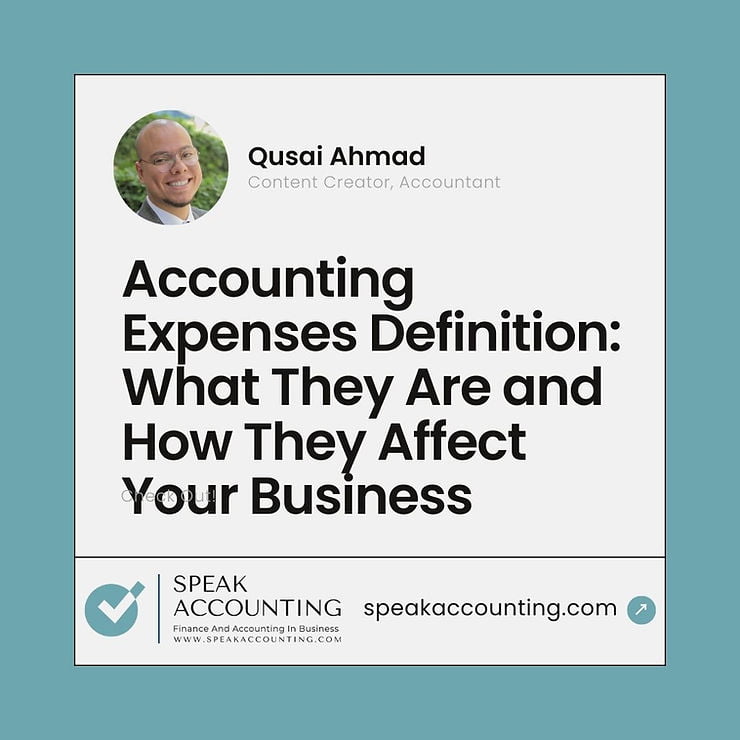Accounting expenses are the costs incurred by a business to generate revenue or operate its activities. Accounting expenses are also known as expenditures, outlays, or charges.
Accounting expenses are an important part of accounting because they affect the income statement, the balance sheet, the cash flow statement, and the tax liability of a business.
Accounting expenses also help managers to measure and control the efficiency and profitability of their business operations.
In this blog post, we will discuss the definition and classification of accounting expenses and how they affect your business.
Accounting Expenses vs Accounting Costs
Before we dive into the definition and classification of accounting expenses, let’s clarify the difference between accounting expenses and accounting costs.
Accounting expenses and accounting costs are both terms that refer to the consumption of resources by a business. However, they have different meanings and implications in accounting.
Accounting expenses are the costs that are recognized and reported in the income statement in the period in which they are incurred. Accounting expenses reduce the net income and the retained earnings of a business.
Accounting costs are the costs that are capitalized and reported in the balance sheet as assets in the period in which they are incurred. Accounting costs increase the total assets and the equity of a business.
For example, suppose a business buys a machine for $10,000 and uses it for 10 years. The purchase price of the machine is an accounting cost that is capitalized and reported as a fixed asset in the balance sheet. The depreciation of the machine, which is $1,000 per year, is an accounting expense that is recognized and reported as a depreciation expense in the income statement.
The Two Main Categories of Accounting Expenses
Accounting expenses can be classified into two main categories: operating expenses and non-operating expenses.
Operating Expenses
Operating expenses are the expenses that are directly related to the core business operations of a business. Operating expenses are also known as operating costs, operating expenditures, or opex.
Operating expenses include:
- Cost of goods sold (COGS): This is the expense that represents the direct cost of producing or purchasing the goods or services that are sold by a business. COGS includes the cost of materials, labor, overhead, and other direct costs that are involved in the production or acquisition of the goods or services. COGS is deducted from the revenue to calculate the gross profit of a business.
- Selling, general, and administrative expenses (SG&A): This is the expense that represents the indirect cost of selling and delivering the goods or services and running the general and administrative functions of a business. SG&A includes the cost of marketing, advertising, sales commissions, distribution, customer service, rent, utilities, salaries, insurance, legal fees, and other indirect costs that are not directly related to the production or acquisition of the goods or services. SG&A is deducted from the gross profit to calculate the operating profit of a business.
- Research and development expenses (R&D): This is the expense that represents the cost of conducting research and developing new or improved products, services, processes, or technologies. R&D is considered as an operating expense because it is essential for the innovation and growth of a business. R&D is deducted from the operating profit to calculate the income before interest and taxes (EBIT) of a business.
Non-Operating Expenses
Non-operating expenses are the expenses that are not directly related to the core business operations of a business. Non-operating expenses are also known as non-operating costs, non-operating expenditures, or non-opex.
Non-operating expenses include:
- Interest expense: This is the expense that represents the cost of borrowing money from lenders or creditors. Interest expense is calculated as the interest rate multiplied by the principal amount of the debt. Interest expense is deducted from the EBIT to calculate the income before taxes (EBT) of a business.
- Tax expense: This is the expense that represents the amount of income tax that a business owes to the government. Tax expense is calculated as the tax rate multiplied by the taxable income of a business. Tax expense is deducted from the EBT to calculate the net income or net profit of a business.
- Extraordinary items: These are the expenses that are unusual, infrequent, and significant in amount. Extraordinary items are not expected to occur again in the foreseeable future and are not part of the normal business operations of a business. Extraordinary items include the losses or gains from natural disasters, lawsuits, frauds, or other events that are beyond the control of a business. Extraordinary items are reported separately in the income statement after the net income or net profit of a business.
The Impact of Accounting Expenses on the Financial Statements and the Tax Liability of a Business
Accounting expenses have a significant impact on the financial statements and the tax liability of a business. Accounting expenses affect the following aspects of a business:
- Income statement: The income statement is the financial statement that summarizes the revenue, expenses, and net income or net profit of a business for a specific period. Accounting expenses are deducted from the revenue to calculate the net income or net profit of a business. The net income or net profit is the bottom line of the income statement and represents the amount of money that a business earns or loses in a period.
- Balance sheet: The balance sheet is the financial statement that summarizes the assets, liabilities, and equity of a business at a specific point in time. Accounting expenses affect the balance sheet indirectly through the net income or net profit of a business. The net income or net profit is added to the retained earnings, which is part of the equity of a business. The equity represents the amount of money that the owners of a business have invested or reinvested in the business.
- Cash flow statement: The cash flow statement is the financial statement that summarizes the cash inflows and outflows of a business for a specific period. Accounting expenses affect the cash flow statement directly or indirectly depending on the type of accounting expense. Operating expenses affect the cash flow from operating activities, which represents the cash generated or used by the core business operations of a business. Non-operating expenses affect the cash flow from financing activities, which represents the cash raised or paid by the borrowing or repaying of debt or the issuing or repaying of equity of a business.
- Tax liability: The tax liability is the amount of income tax that a business owes to the government for a specific period. Accounting expenses affect the tax liability of a business by reducing the taxable income of a business. The taxable income is the amount of income that is subject to income tax. The taxable income is calculated by adjusting the net income or net profit of a business for the differences between the accounting rules and the tax rules. Accounting expenses that are deductible for tax purposes reduce the taxable income and the tax liability of a business. Accounting expenses that are not deductible for tax purposes do not affect the taxable income and the tax liability of a business.
Conclusion
Accounting expenses are the costs incurred by a business to generate revenue or operate its activities. Accounting expenses are classified into two main categories: operating expenses and non-operating expenses. Accounting expenses have a significant impact on the financial statements and the tax liability of a business.
By understanding the definition and classification of accounting expenses and how they affect your business, you can improve your accounting skills and financial literacy, as well as the management and performance of your business.
We hope that this blog post has helped you understand and appreciate the accounting expenses definition and how they affect your business. If you have any questions or comments, please feel free to leave them below. Thank you for reading and happy learning!




